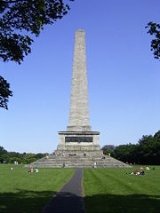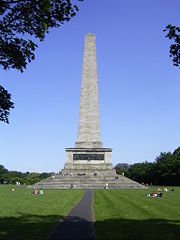
Wellington Monument, Dublin
Encyclopedia
The Wellington Monument (or more correctly the Wellington Testimonial; ) is an obelisk
located in the Phoenix Park
, Dublin, Ireland
.
The testimonial is situated at the southeast end of the Park, overlooking Kilmainham
and the River Liffey
. The structure is 62 metres (203.4 ft) tall, making it the largest obelisk in Europe.
 The Wellington Testimonial was built to commemorate the victories of Arthur Wellesley, 1st Duke of Wellington
The Wellington Testimonial was built to commemorate the victories of Arthur Wellesley, 1st Duke of Wellington
. Wellington, also known as the 'Iron Duke', was born in Dublin. Originally planned to be located in Merrion Square
, it was built in the Phoenix Park after opposition from the square's residents.
The Testimonial was designed by the architect Sir Robert Smirke and the foundation stone was laid in 1817. However, in 1820 it ran short of its construction costs and therefore remained unfinished until 18 June 1861 when it was opened to the public. There were also plans for a statue of Wellesley on horseback but the shortage of funds ruled that out.
A Dublin legend suggests that a fund-raising dinner was held in the vault under the pillar in 1820, after which the vault was sealed up, leaving the dining tables and chairs behind. Several weeks later it was noticed that a butler had not been seen since the dinner, and it was assumed that he had drunk too much wine and remained unconscious and unnoticed behind a screen while the room was being sealed.
- three of which have pictorial representations of his career while the fourth has an inscription. The plaques depict 'Civil and Religious Liberty' by John Hogan, 'Waterloo' by Thomas Farrell
and the 'Indian Wars' by Joseph Robinson Kirk
. The inscription reads:
Obelisk
An obelisk is a tall, four-sided, narrow tapering monument which ends in a pyramid-like shape at the top, and is said to resemble a petrified ray of the sun-disk. A pair of obelisks usually stood in front of a pylon...
located in the Phoenix Park
Phoenix Park
Phoenix Park is an urban park in Dublin, Ireland, lying 2–4 km west of the city centre, north of the River Liffey. Its 16 km perimeter wall encloses , one of the largest walled city parks in Europe. It includes large areas of grassland and tree-lined avenues, and since the seventeenth...
, Dublin, Ireland
Ireland
Ireland is an island to the northwest of continental Europe. It is the third-largest island in Europe and the twentieth-largest island on Earth...
.
The testimonial is situated at the southeast end of the Park, overlooking Kilmainham
Kilmainham
Kilmainham is a suburb of Dublin south of the River Liffey and west of the city centre, in the Dublin 8 postal district.-History:In the Viking era, the monastery was home to the first Norse base in Ireland....
and the River Liffey
River Liffey
The Liffey is a river in Ireland, which flows through the centre of Dublin. Its major tributaries include the River Dodder, the River Poddle and the River Camac. The river supplies much of Dublin's water, and a range of recreational opportunities.-Name:The river was previously named An Ruirthech,...
. The structure is 62 metres (203.4 ft) tall, making it the largest obelisk in Europe.
History

Arthur Wellesley, 1st Duke of Wellington
Field Marshal Arthur Wellesley, 1st Duke of Wellington, KG, GCB, GCH, PC, FRS , was an Irish-born British soldier and statesman, and one of the leading military and political figures of the 19th century...
. Wellington, also known as the 'Iron Duke', was born in Dublin. Originally planned to be located in Merrion Square
Merrion Square
Merrion Square is a Georgian square on the southside of Dublin city centre. It was laid out after 1762 and was largely complete by the beginning of the 19th century. It is considered one of the city's finest surviving squares...
, it was built in the Phoenix Park after opposition from the square's residents.
The Testimonial was designed by the architect Sir Robert Smirke and the foundation stone was laid in 1817. However, in 1820 it ran short of its construction costs and therefore remained unfinished until 18 June 1861 when it was opened to the public. There were also plans for a statue of Wellesley on horseback but the shortage of funds ruled that out.
A Dublin legend suggests that a fund-raising dinner was held in the vault under the pillar in 1820, after which the vault was sealed up, leaving the dining tables and chairs behind. Several weeks later it was noticed that a butler had not been seen since the dinner, and it was assumed that he had drunk too much wine and remained unconscious and unnoticed behind a screen while the room was being sealed.
Features of the Testimonial
There are four bronze plaques cast from cannons captured at WaterlooBattle of Waterloo
The Battle of Waterloo was fought on Sunday 18 June 1815 near Waterloo in present-day Belgium, then part of the United Kingdom of the Netherlands...
- three of which have pictorial representations of his career while the fourth has an inscription. The plaques depict 'Civil and Religious Liberty' by John Hogan, 'Waterloo' by Thomas Farrell
Thomas Farrell (sculptor)
Thomas Farrell , was an Irish sculptor.He was born in Mecklenburgh Street , Dublin, one of six sons of Terence Farrell, sculptor. He trained as a scuptor in his father's workshops. In 1842 he entered the modelling school of the Royal Dublin Society and became acquainted with the neoclassical school...
and the 'Indian Wars' by Joseph Robinson Kirk
Joseph Robinson Kirk
Joseph Robinson Kirk was a noted Irish sculptor.He was born in Dublin, the eldest son of Thomas Kirk. He lived in Jervis Street and studied with his father and at the Dublin Society's School.He became master of the RDS modelling school in 1852 and in 1854 he became a member of the Royal Hibernian...
. The inscription reads:
- Asia and Europe, saved by thee, proclaim
- Invincible in war thy deathless name,
- Now round thy brow the civic oak we twine
- That every earthly glory may be thine.

